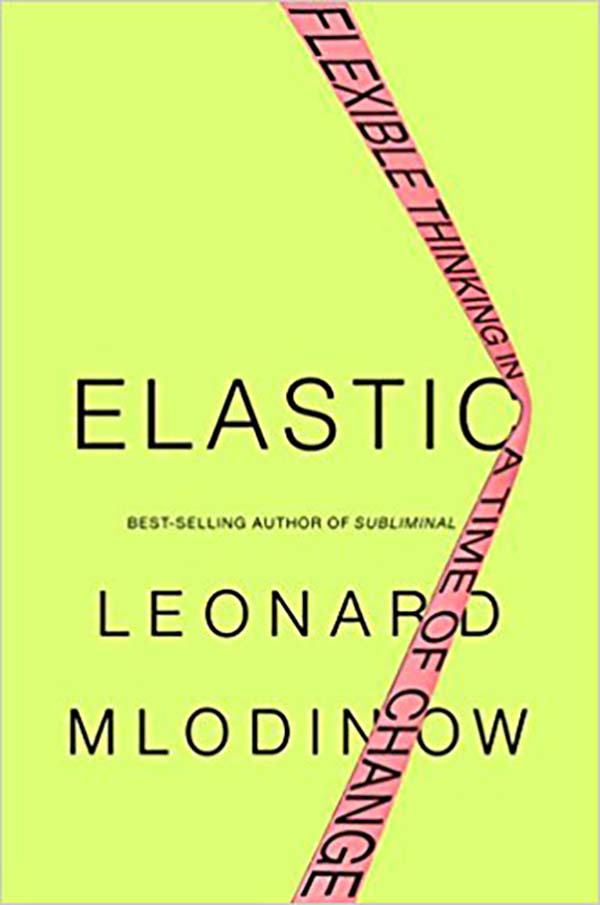“Logic will get you from point A to point B, but imagination will take you everywhere.” — Albert Einstein
In her 20s, my mother was an experienced home dressmaker. One day, the collar in a printed pattern stumped her. She tried this way and that for hours, but the collar just wouldn’t lie flat. Exasperated, she switched off the machine and went to bed.

BOOK REVIEW — “Elastic: Flexible Thinking in a Time of Change,” by Leonard Mlodinow. Pantheon, 252 pages.
In the middle of the night, she awoke, a dream fresh in her mind. She returned to her sewing and fixed the recalcitrant collar. Like Friedrich August Kekulé’s dream of a snake biting its own tail, which solved the riddle of benzene’s molecular structure, the solution to my mother’s spatial conundrum visited when she gave her well-prepared mind a chance to rest.
Every day, each of us encounters obstacles, from insignificant to life-altering, from personal to global. We cannot depend on the dreaming mind to surmount even a tiny fraction of them. But even in our waking life, we have the power to replicate the expanded thinking of dreams — or, as Leonard Mlodinow puts it in the term that gave his new book its title, “elastic” thinking.
Mlodinow, a theoretical physicist who is also a best-selling science writer (“Subliminal”), explains that in any situation demanding alertness, humans tend to employ one of two types of thinking. The analytical, a product of the brain’s left hemisphere, serves us well by default, “because ordinary and unoriginal ideas are usually sufficient.” But not when circumstances change unexpectedly. That is when we need elastic thinking — unconventional, comfortable with ambiguity, and unafraid to defy assumptions. This kind of thinking is behind some of history’s greatest leaps into the unknown. Purely analytical thinking could not have devised an artificial version of the barbs on burdock seeds, later patented as Velcro. Only an unstructured mind could watch a round stone roll downhill and think of replicating it as a wheel.
How to summon our power to think elastically? First of all, play — and its cousin, daydreaming — can provide forums for the subconscious to form novel associations. (Think of Einstein’s delightful thought experiments — how he conceived the theory of relativity by imagining himself riding a beam of light.) Unfortunately, compulsively busy people regard activities like doodling and staring into space as a waste of time. And in this age of the ubiquitous pocket helper-brain, Mlodinow laments that the “dearth of idle time” fences off exciting new paths that the mind might otherwise wander. In this regard, Mlodinow asserts, people with ADHD may have a distinct advantage over others.
Then there’s the double-edged matter of confidence. While self-confidence can lead to the successful implementation of an idea, overconfidence can block idea generation in the first place. “When you are an expert, your deep knowledge is obviously of great value in facing the usual challenges of your profession,” Mlodinow writes, “but your immersion in that body of conventional wisdom can impede you from creating or accepting new ideas, and hamper you when you are confronted with novelty and change.”
Intellectual challenges have always been with us, and evolution has given us the means to tackle them, if we loosen rigid thinking with rhythmic exercise (like walking), meditation, mind-altering substances, fatigue, or something as simple as a good mood. Variations of these techniques have been part of the human toolbox for millennia, and Mlodinow devotes an entire chapter to them.
Most of us have to make a concerted effort to be mindful and open to the unfamiliar. But it’s not as difficult as it may seem. The burgeoning study of neuroplasticity — popularized by psychiatrist and psychoanalyst Norman Doidge in his 2007 best-seller “The Brain That Changes Itself” — makes it clear that you can teach an old dog new tricks. All organisms need to learn, and the ability doesn’t shut down after maturity (unless you let it).
“Elastic” does not mention Doidge, or the Nobelist Daniel Kahneman, whose “Thinking, Fast and Slow” (2011) explains the mechanisms behind insidious brain traps like confirmation bias and convincingly undermines his fellow economists’ common assumption that marketplace decisions are rational. Mlodinow sidesteps discussion of such fallacies, concentrating instead on what usually works for us.
It is strange that a book that purports to cast a wide net on human cognition sticks so close to home. (Literally, as it turns out: A few anecdotes come from his own family.) Instead of citing relevant research, he devotes multiple pages to famous people and their original ideas, among them Stephen Hawking and Deepak Chopra (his collaborators on previous books) and Seth MacFarlane, of “Family Guy” fame. His discussion of the novelist Isabel Allende’s mixed success with ayahuasca as a cure for writer’s block is an eye-opener, but on the whole these celebrity testimonials are too weak to provide much insight into the value of elastic thinking. Similarly ineffective, and even distracting, are the mini-quizzes (e.g., to measure mindfulness) that he inserts into several chapters. He’d have done well to interview one or two science fiction writers for their out-there visions of a better world, supplemented by insights into their imaginative processes.
Perhaps the quintessential form of elastic thinking is humor. The famous wit of many luminaries in Mlodinow’s own field, from Einstein to Hawking, attests to that. The book would have benefited from an appreciation of the mental agility of brilliant comics like Robin Williams, and an explanation of why humans make jokes in the first place. But he only skims the subject. These and other lost opportunities to extol the merits of nonlinear problem-solving and decision-making water down an otherwise engaging and timely book.
Louise Fabiani’s critical essays on science and culture have appeared in Science, Pacific Standard, Earth Island Journal, The TLS, The American Scholar, The Rumpus, and many others.










